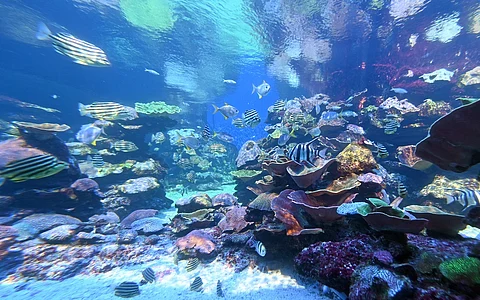

Western Australia faces its most severe coral bleaching event on record due to a marine heatwave, with mortality rates reaching up to 90% in some areas.
The event spans 1,500 km and is part of the fourth mass bleaching event announced by NOAA.
Scientists warn that climate change is accelerating these occurrences, threatening coral recovery and ecosystem health.
A marine heatwave has caused severe heat stress to coral reefs off the Western Australian coast, resulting in bleaching and mortality ranging between 11 to over 90 per cent in some areas.
The coral bleaching reported across 1,500 km has been official documented as the longest, largest and most intense event on record for Western Australia, scientists have said.
The bleaching is part of the ongoing fourth mass coral bleaching event announced by the National Oceanic and Atmospheric Administration (NOAA) on April 15, 2024.
Record breaking ocean temperatures in 2023 and 2024 enabled sea surface temperatures in Australian seas to remain hottest on record, which continued to be the case for each month through 2025.
The persistence of marine heatwave conditions across the northwest from winter 2024 to autumn 2025 underpin the significance of this warming event, the report released on August 12 noted.
“The length and intensity of the heat stress, and its footprint across multiple regions, is something we’ve never seen before on most of the reefs in WA. For individual coral reefs we are still crunching the numbers around Degree Heating Weeks (DHW) — a measure of heat stress on corals — but early estimates are over 15 DHWs on all reefs and up to 30 DHWs at some Pilbara reefs. Eight DHWs is the level of heat stress we generally consider severe enough to cause coral mortality,” the report published by Australian Institute of Marine Science (AIMS) said.
AIMS coral scientist Nicole Ryan, who coordinates the WA Coral Bleaching Group, said in a statement, “The heat stress will beat records set during the 2011 La Nina and the 2016 El Nino on all but the southernmost reefs, in the south of Ningaloo, Shark Bay and the Abrolhos Islands.”
Ningaloo is considered precious for its unique marine ecosystem and home to whale sharks, manta rays and humpback whales, turtles and technicolour coral gardens.
According to the findings, bleaching and mortality at Ashmore Reef ranged between 11 and 30 per cent. In the Mermaid and Clerke reefs in the Rowley Shoals, the field surveys from April showed high mortality ranging 61 to 90 per cent across the long-term monitored sites. The bleaching affected all habitats, from sheltered lagoons to deep outer reef slope up to 30 metres.
“At inshore southern Kimberley reefs, AIMS scientists supported Bardi Jawi Indigenous rangers to conduct bleaching surveys in February, recording high levels (31 to 60 per cent) of bleaching at most monitoring sites. They reported coral mortality in March,” the statement said.
At monitored sites in Ningaloo, surveys pointed out that in May, bleaching and mortality peaked up to 60 per cent, with areas in Tantabiddi and Jurabi especially hit hard.
Coral species, especially Pocillopora and Acropora, were among the worst affected. The corals also suffered damage from cyclones, including coral injury and high coral rubble.
The scientists said all coral species, and across all genera, were impacted by bleaching. Moreover, disease and coral predators such as Drupella were also recorded during the surveys.
AIMS senior research scientist James Gilmour said climate change is accelerating these events, making them more frequent, intense and widespread, allowing the coral reefs little time to recover. It is estimated that the corals need about 10 to 15 years to recover fully.
“Western Australia’s coral reefs are well managed. But climate change caused by carbon emissions remains the greatest threat to our coral reefs, and all reefs globally,” the report found.
“We cannot allow climate change to strip our tropical and southern reefs of life. The science is crystal clear — every fraction of a degree matters, and the longer we delay action, the more we stand to lose,” AIMS Chief Executive Paul Gamblin said.
The full impact of the bleaching would be understood with additional surveys in November, the experts said.